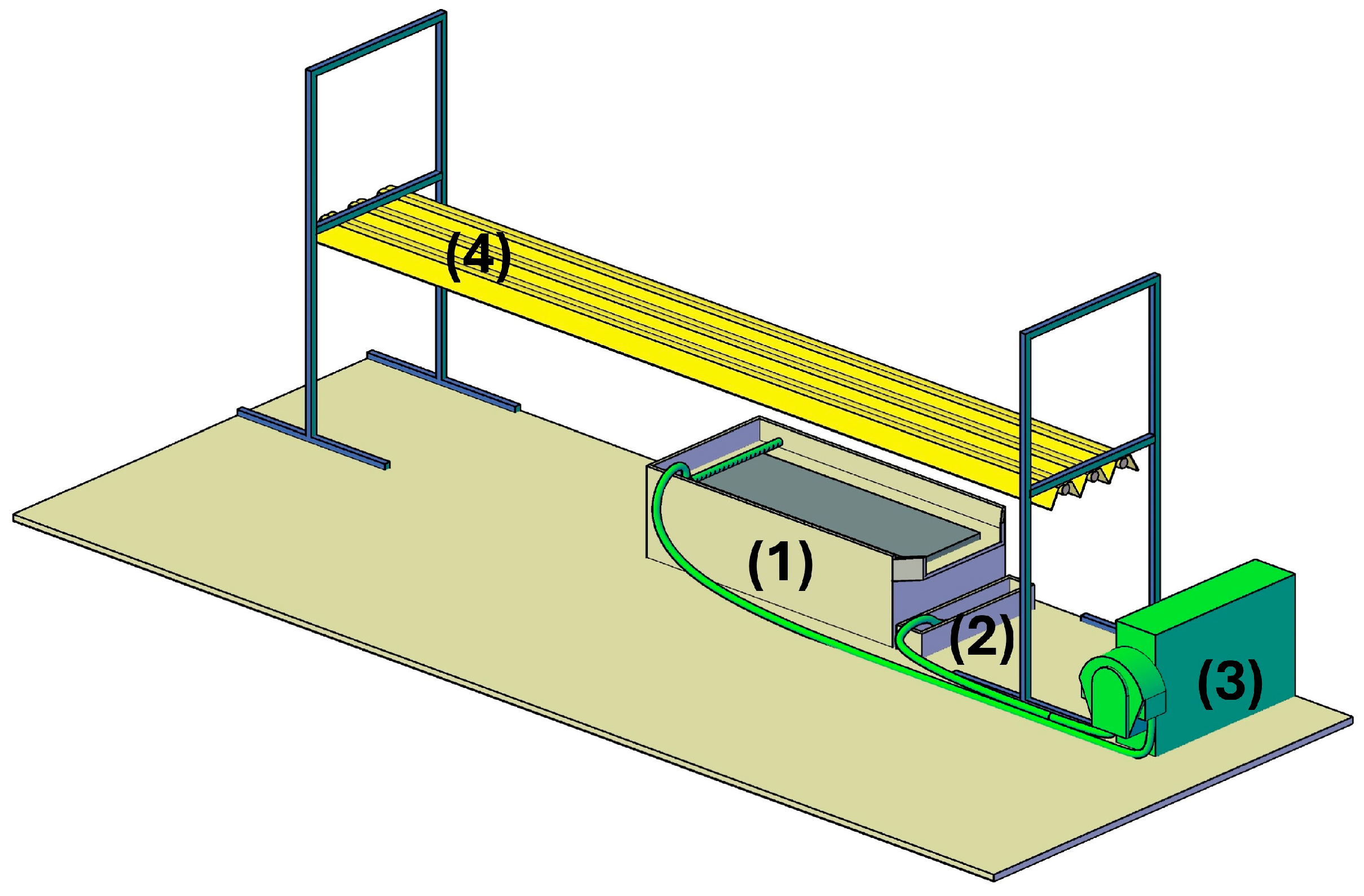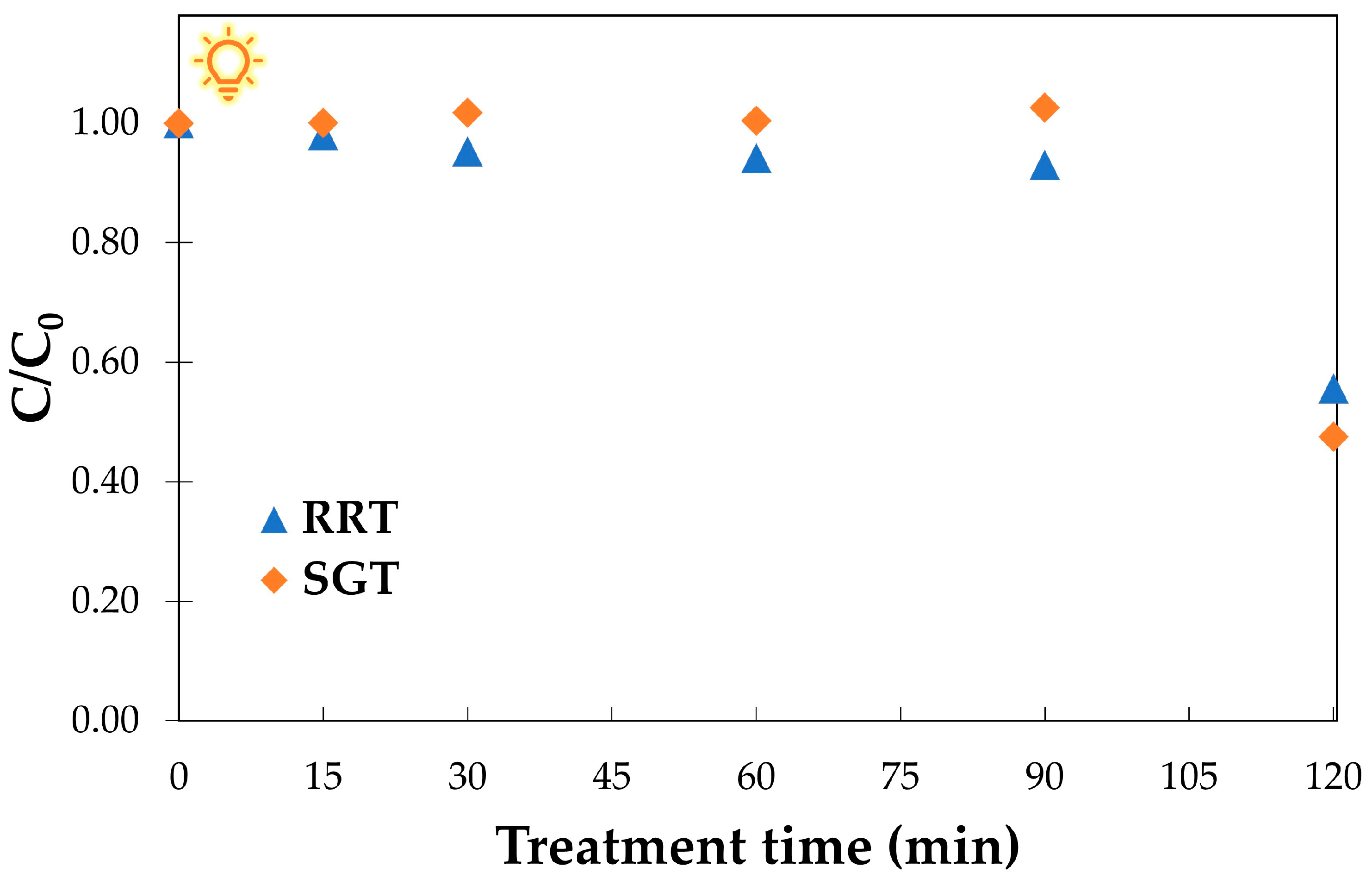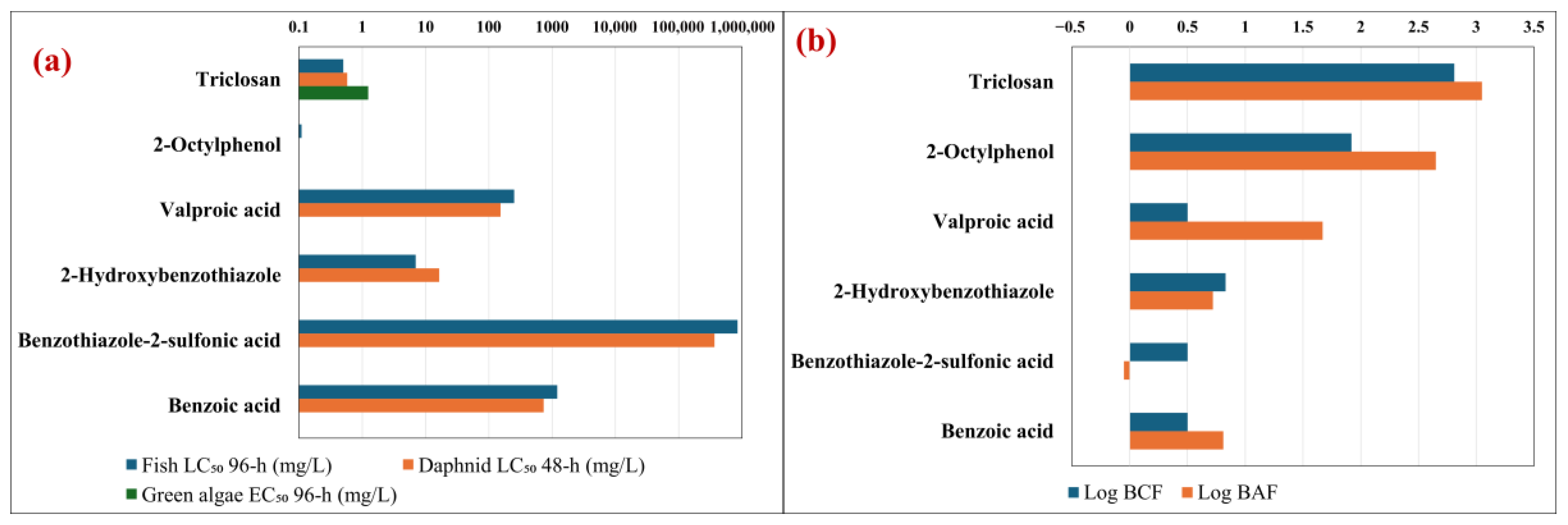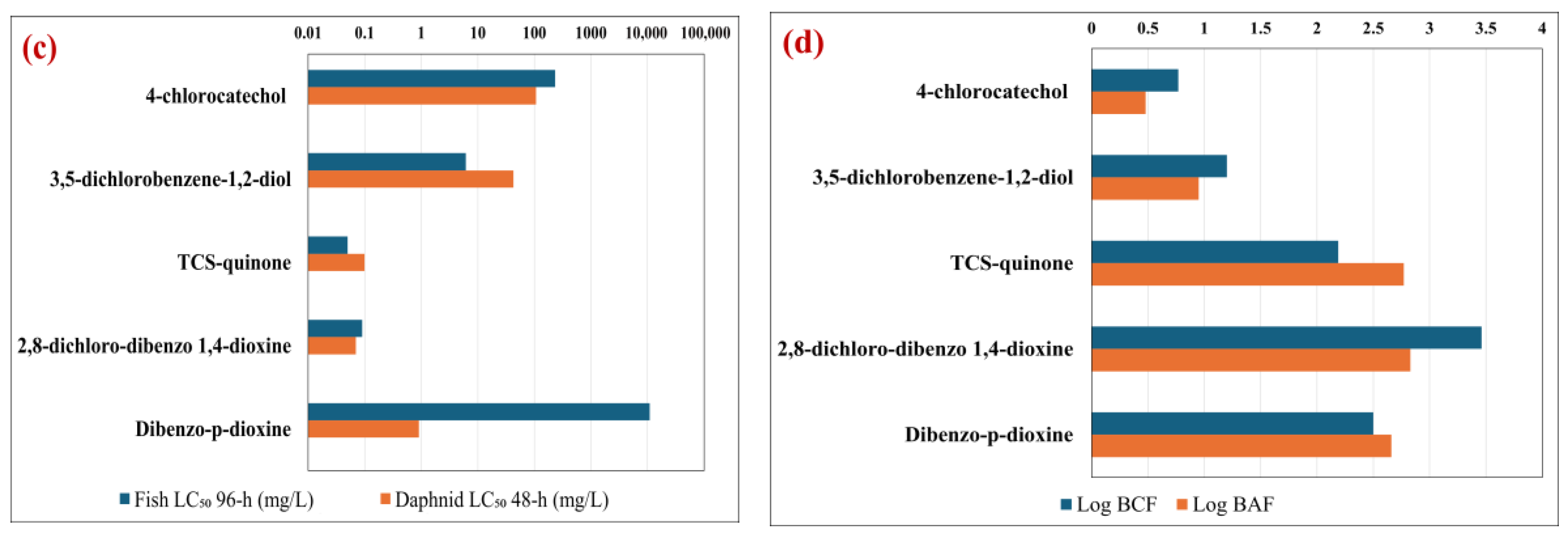Assessing the Efficiency of TiO2-Modified Rubber Tiles for Photocatalytic Degradation of Rainwater Runoff Contaminants
Abstract
Featured Application
Abstract
1. Introduction
2. Experimental Section
2.1. Materials
2.1.1. Water Samples
2.1.2. Recycled Rubber Tiles (Reference and Modified with TiO2)
2.2. Reactor Setup
2.3. Water Leachate Testing (LC/MS QTOF)
2.4. Environmental Impact Estimation
3. Results and Discussion
3.1. Detection of Micropollutants in Rainwater Samples
3.2. Identification and Quantification of Triclosan
3.3. Triclosan Degradation Efficiency over Photocatalytic (SGT) and Non-Photocatalytic (RRT) Rubber Tiles
3.4. Indicative Kinetics of Triclosan Degradation
3.5. Degradation Products and Mechanistic Insights
3.6. Environmental Relevance of Co-Detected Compounds: A Qualitative Insight
3.7. Environmental Impact Results
4. Limitations and Practical Implications
- Semi-Quantitative Detection of Co-Compounds: While Agilent MassHunter Profinder Software version B.10.00 allowed for trend analysis of several additional organic compounds (HOBT, benzothiazole-2-sulfonic acid, valproic acid, and benzoic acid), their absolute concentrations remain unknown due to lack of calibration standards. As such, their environmental relevance can be only qualitatively inferred.
- Leaching and By-Product Formation: Although SGT showed greater photocatalytic degradation efficiency for triclosan and 2-octylphenol, some compounds appeared or increased in concentration during the UV treatment phase. This suggests that the rubber material itself may contribute to the chemical load through leaching or photochemical transformation, especially under UV irradiation. Without additional control experiments, attribution remains speculative.
- Matrix Effects and Environmental Conditions: The rainwater matrix used in this study may not represent all environmental conditions (e.g., variation in pH, dissolved organic matter, or ionic strength), which can significantly influence adsorption and photocatalytic processes. Further testing under diverse environmental scenarios is necessary.
- Indicative Kinetics: Kinetic estimates are based on a two-point fit in the 90–120 min interval because no net decrease was observed in the first 90 min. These values are therefore indicative and specific to the active window. Working with authentic rainwater inherently limits reproducibility and comparability with model systems; still, it provides decision-relevant insights for real-world scenarios.
- Byproduct Toxicity: While the degradation of primary contaminants is desirable, the formation of photoproducts such as chlorinated phenols or benzothiazole derivatives may pose additional ecological risks. Future studies should address the toxicity of by-products using appropriate bioassays.
- Flow Rate: Flow variability is an important factor under real-world conditions. However, due to the practical and logistical constraints of the current experimental setup, this study was limited to testing a single flow rate of 26.5 cm3/s. This value was selected as a representative condition to simulate a moderate runoff scenario within the capabilities of the laboratory system. While the flow rate may constitute a limitation of this study, emphasis is placed on the need for future research to investigate a wider range of flow rates in order to provide a more comprehensive assessment of practical applicability.
- Cost Estimation: A preliminary consideration of material costs suggests that recycled rubber tiles are ~EUR 20 per m2, while TiO2 is ~EUR 2 per kg. Although these are indicative values, comprehensive life-cycle cost analyses factoring in durability and maintenance are required to evaluate economic feasibility.
- Urban Water Management: The integration of photocatalytically active surfaces, especially in stormwater infrastructure (e.g., pavements, tiles, drainage systems, etc.), could help reduce the burden of emerging contaminants at the source.
- Material Design: Recycled rubber tiles modified with TiO2 represent a circular economy approach. However, attention must be paid to material stability and potential additive leaching under real-world stressors such as sunlight, abrasion, and variable temperatures.
- Monitoring Strategy: The use of high-resolution mass spectrometry with suspect and non-target screening proves valuable for environmental monitoring. A combination of targeted quantification and broader qualitative screening can better capture the chemical complexity of runoff.
- Future Development: Future research should aim to optimize photocatalyst immobilization, assess long-term performance and reusability, and integrate life-cycle assessments to evaluate the sustainability of such systems in real-world applications.
5. Conclusions
Supplementary Materials
Author Contributions
Funding
Institutional Review Board Statement
Informed Consent Statement
Data Availability Statement
Acknowledgments
Conflicts of Interest
References
- Shuliakevich, A.; Schroeder, K.; Nagengast, L.; Wolf, Y.; Brückner, I.; Muz, M.; Behnisch, P.A.; Hollert, H.; Schiwy, S. Extensive rain events have a more substantial impact than advanced effluent treatment on the endocrine-disrupting activity in an effluent-dominated small river. Sci. Total Environ. 2022, 807, 150887. [Google Scholar] [CrossRef]
- Endocrine Society Endocrine-Disrupting Chemicals (EDCs), (n.d.). Available online: https://www.endocrine.org/ (accessed on 18 June 2025).
- Martínez, S.; Morales-Mejía, J.C.; Hernández, P.P.; Santiago, L.; Almanza, R. Solar photocatalytic oxidation of Triclosan with TiO2 immobilized on volcanic porous stones on a CPC pilot scale reactor. Energy Procedia 2014, 57, 3014–3020. [Google Scholar] [CrossRef]
- Na Nagara, V.; Sarkar, D.; Elzinga, E.J.; Datta, R. Removal of heavy metals from stormwater runoff using granulated drinking water treatment residuals. Environ. Technol. Innov. 2022, 28, 102636. [Google Scholar] [CrossRef]
- Szmagliński, J.; Nawrot, N.; Pazdro, K.; Walkusz-Miotk, J.; Wojciechowska, E. The fate and contamination of trace metals in soils exposed to a railroad used by Diesel Multiple Units: Assessment of the railroad contribution with multi-tool source tracking. Sci. Total Environ. 2021, 798, 149300. [Google Scholar] [CrossRef]
- Shaheed, R.; Wan Mohtar, W.H.M.; El-Shafie, A. Ensuring water security by utilizing roof-harvested rainwater and lake water treated with a low-cost integrated adsorption-filtration system. Water Sci. Eng. 2017, 10, 115–124. [Google Scholar] [CrossRef]
- Chen, C.; Guo, W.; Ngo, H.H. Pesticides in stormwater runoff—A mini review. Front. Environ. Sci. Eng. 2019, 13, 72. [Google Scholar] [CrossRef]
- Marszałek, A.; Dudziak, M.; Kudlek, E. Analysis of organic and inorganic compounds in rainwater from the highway and its treatment in membrane processes. Desalin. Water Treat. 2023, 305, 217–226. [Google Scholar] [CrossRef]
- Bilal, M.; Barceló, D.; Iqbal, H.M.N. Persistence, ecological risks, and oxidoreductases-assisted biocatalytic removal of triclosan from the aquatic environment. Sci. Total Environ. 2020, 735, 139194. [Google Scholar] [CrossRef]
- Wang, Z.; Li, X.; Li, Y.; Liu, H.; Ki Lin, C.S.; Sun, J.; Wang, Q. Unveiling the occurrence and ecological risks of triclosan in surface water through meta-analysis. Environ. Pollut. 2024, 361, 124901. [Google Scholar] [CrossRef] [PubMed]
- Constantin, L.A.; Nitoi, I.; Cristea, N.I.; Constantin, M.A. Possible degradation pathways of triclosan from aqueous systems via TiO2 assisted photocatalyis. J. Ind. Eng. Chem. 2018, 58, 155–162. [Google Scholar] [CrossRef]
- Miyagawa, S.; Sato, T.; Iguchi, T. Octylphenol. In Handbook of Hormones; Elsevier: Amsterdam, The Netherlands, 2016; pp. 575–576. [Google Scholar]
- European Chemicals Agency (ECHA) Member State Committee Support Document for Identification of 4-(1,1,3,3-Tetramethylbutyl)Phenol, 4-Tert-Octylphenol. 2011, 168. Available online: https://euon.echa.europa.eu/documents/10162/17224/procedure_identification_of_svhc_en.pdf (accessed on 29 June 2025).
- DEFRA (Department of Environment Foor and Rural Affairs) Risk Reduction Strategy and Analysis of Advantages and Drawbacks for 4-tert-octylphenol J501f/OP RRS. Department for Environment, Food and Rural Affair. 2008. Available online: https://assets.publishing.service.gov.uk/media/5a7ae2a440f0b66a2fc037d6/op-rrs-aad-report.pdf (accessed on 29 June 2025).
- Benjak, P.; Radetić, L.; Presečki, I.; Brnardić, I.; Sakač, N.; Grčić, I. Microplastic-Related Leachate from Recycled Rubber Tiles: The Role of TiO2 Protective Coating. Surfaces 2024, 7, 786–800. [Google Scholar] [CrossRef]
- Reddy, C.M.; Quinn, J.G. Environmental chemistry of benzothiazeles derived from rubber. Environ. Sci. Technol. 1997, 31, 2847–2853. [Google Scholar] [CrossRef]
- University of Hertfordshire PPDB: Pesticide Properties DataBase. Available online: https://sitem.herts.ac.uk/aeru/ppdb/en/Reports/1475.htm (accessed on 28 June 2025).
- National Library of Medicine, PubChem. Available online: https://pubchem.ncbi.nlm.nih.gov/ (accessed on 28 June 2025).
- Uzel, G.; Oylumlu, E.; Durmus, L.; Ciraci, C. Duality of Valproic Acid Effects on Inflammation, Oxidative Stress and Autophagy in Human Eosinophilic Cells. Int. J. Mol. Sci. 2023, 24, 13446. [Google Scholar] [CrossRef]
- Jung, C.; Son, A.; Her, N.; Zoh, K.D.; Cho, J.; Yoon, Y. Removal of endocrine disrupting compounds, pharmaceuticals, and personal care products in water using carbon nanotubes: A review. J. Ind. Eng. Chem. 2015, 27, 1–11. [Google Scholar] [CrossRef]
- Xiao, Z.; Pramanik, A.; Basak, A.K.; Prakash, C.; Shankar, S. Material recovery and recycling of waste tyres—A review. Clean. Mater. 2022, 5, 100115. [Google Scholar] [CrossRef]
- Graça, C.A.L.; Rocha, F.; Gomes, F.O.; Rocha, M.R.; Homem, V.; Alves, A.; Ratola, N. Presence of metals and metalloids in crumb rubber used as infill of worldwide synthetic turf pitches: Exposure and risk assessment. Chemosphere 2022, 299, 1343790. [Google Scholar] [CrossRef]
- Duque-Villaverde, A.; Sóñora, S.; Dagnac, T.; Roca, E.; Llompart, M. Metal and metalloid content in real urban synthetic surfaces made of recycled tire crumb rubber including playgrounds and football fields. Sci. Total Environ. 2025, 975, 179267. [Google Scholar] [CrossRef]
- Benjak, P.; Tomaš, M.; Ptiček Siročić, A.; Brnardić, I.; Florijanić, F.; Grčić, I. The Role of TiO2 during the Accelerated Aging of Recycled Rubber Tiles. Chemistry 2024, 6, 1111–1132. [Google Scholar] [CrossRef]
- Yang, Q.; Jones, W.; Wells, P.P.; Morgan, D.; Dong, L.; Hu, B.; Dimitratos, N.; Dong, M.; Bowker, M.; Besenbacher, F.; et al. Exploring the mechanisms of metal co-catalysts in photocatalytic reduction reactions: Is Ag a good candidate? Appl. Catal. A Gen. 2016, 518, 213–220. [Google Scholar] [CrossRef]
- Feng, H.; Zhang, M.H.; Yu, L.E. Hydrothermal synthesis and photocatalytic performance of metal-ions doped TiO2. Appl. Catal. A Gen. 2012, 413–414, 238–244. [Google Scholar] [CrossRef]
- Freire, J.M.A.; Matos, M.A.F.; Abreu, D.S.; Becker, H.; Diógenes, I.C.N.; Valentini, A.; Longhinotti, E. Nitrate photocatalytic reduction on TiO2: Metal loaded, synthesis and anions effect. J. Environ. Chem. Eng. 2020, 8, 103844. [Google Scholar] [CrossRef]
- Nguyen, D.T.; Hong, S.S. Synthesis of metal ion-doped TiO2 nanoparticles using two-phase method and their photocatalytic activity under visible light irradiation. J. Nanosci. Nanotechnol. 2016, 16, 1911–1915. [Google Scholar] [CrossRef]
- Lertthanaphol, N.; Pienutsa, N.; Chusri, K.; Sornsuchat, T.; Chanthara, P.; Seeharaj, P.; Kim-Lohsoontorn, P.; Srinives, S. One-Step Hydrothermal Synthesis of Precious Metal-Doped Titanium Dioxide–Graphene Oxide Composites for Photocatalytic Conversion of CO2 to Ethanol. ACS Omega 2021, 6, 35769–35779. [Google Scholar] [CrossRef]
- Pozan, G.S.; Isleyen, M.; Gokcen, S. Transition metal coated TiO2 nanoparticles: Synthesis, characterization and their photocatalytic activity. Appl. Catal. B Environ. 2013, 140–141, 537–545. [Google Scholar] [CrossRef]
- Murugan, M.; Subasri, R.; Rao, T.N.; Gandhi, A.S.; Murty, B.S. Synthesis, characterization and demonstration of self-cleaning TiO2 coatings on glass and glazed ceramic tiles. Prog. Org. Coatings 2013, 76, 1756–1760. [Google Scholar] [CrossRef]
- Brnardić, I.; Huskić, M.; Umek, P.; Fina, A.; Grgurić, T.H. Synthesis of silane functionalized sodium titanate nanotubes and their influence on thermal and mechanical properties of epoxy nanocomposite. Phys. Status Solidi Appl. Mater. Sci. 2013, 210, 2284–2291. [Google Scholar] [CrossRef]
- United Nations Sustainable Development Goals (SDGs). Available online: https://sdgs.un.org/goals (accessed on 22 August 2025).
- Leng, Z.; Yu, H. Novel Method of Coating Titanium Dioxide on to Asphalt Mixture Based on the Breath Figure Process for Air-Purifying Purpose. J. Mater. Civ. Eng. 2016, 28, 04015188. [Google Scholar] [CrossRef]
- Boonen, E.; Beeldens, A. Recent photocatalytic applications for air purification in Belgium. Coatings 2014, 4, 553–573. [Google Scholar] [CrossRef]
- La Russa, M.F.; Rovella, N.; Alvarez De Buergo, M.; Belfiore, C.M.; Pezzino, A.; Crisci, G.M.; Ruffolo, S.A. Nano-TiO2 coatings for cultural heritage protection: The role of the binder on hydrophobic and self-cleaning efficacy. Prog. Org. Coat. 2016, 91, 1–8. [Google Scholar] [CrossRef]
- Gherardi, F.; Maravelaki, P.N. Advances in the application of nanomaterials for natural stone conservation. RILEM Tech. Lett. 2022, 7, 20–29. [Google Scholar] [CrossRef]
- Ruffolo, S.A.; Francesco, M.; Russa, L. Nanostructured Coatings for Stone Protection: An Overview. Front. Mater. 2019, 6. [Google Scholar] [CrossRef]
- Esposito, C.; Ingrosso, C.; Petronella, F.; Comparelli, R.; Striccoli, M.; Agostiano, A.; Frigione, M.; Curri, M.L. Progress in Organic Coatings A designed UV—Vis light curable coating nanocomposite based on colloidal TiO2 NRs in a hybrid resin for stone protection. Prog. Org. Coat. 2018, 122, 290–301. [Google Scholar] [CrossRef]
- Nazir, M.; Irfan, M.; Ali, I.; Abdul, M. Photonics and Nanostructures—Fundamentals and Applications Revealing antimicrobial and contrasting photocatalytic behavior of metal chalcogenide deposited P25-TiO2 nanoparticles. Photonics Nanostruct.-Fundam. Appl. 2019, 36, 100721. [Google Scholar] [CrossRef]
- Dds, A.S.; Bahador, A.; Khalil, S.; Saffar, A.; Dds, S.; Zaman, M. The effect of TiO2 and SiO2 nanoparticles on flexural strength of poly (methyl methacrylate) acrylic resins. J. Prosthodont. Res. 2013, 57, 15–19. [Google Scholar] [CrossRef]
- Salama, A.; Kamel, B.M.; Osman, T.A.; Rashad, R.M. Investigation of mechanical properties of UHMWPE composites reinforced with HAP þ TiO2 fabricated by solvent dispersing technique. J. Mater. Res. Technol. 2022, 21, 4330–4343. [Google Scholar] [CrossRef]
- Loddo, V.; Bellardita, M.; Camera-Roda, G.; Parrino, F.; Palmisano, L. Heterogeneous Photocatalysis: A Promising Advanced Oxidation Process; Elsevier: Amsterdam, The Netherlands, 2018; ISBN 9780128135495. [Google Scholar]
- Sriwong, C.; Wongnawa, S.; Patarapaiboolchai, O. Photocatalytic activity of rubber sheet impregnated with TiO2 particles and its recyclability. Catal. Commun. 2008, 9, 213–218. [Google Scholar] [CrossRef]
- Datta, J.; Kosiorek, P.; Włoch, M. Effect of high loading of titanium dioxide particles on the morphology, mechanical and thermo-mechanical properties of the natural rubber-based composites. Iran. Polym. J. (Engl. Ed.) 2016, 25, 1021–1035. [Google Scholar] [CrossRef]
- Byrne, C.; Subramanian, G.; Pillai, S.C. Recent advances in photocatalysis for environmental applications. J. Environ. Chem. Eng. 2018, 6, 3531–3555. [Google Scholar] [CrossRef]
- Miranda-García, N.; Suárez, S.; Sánchez, B.; Coronado, J.M.; Malato, S.; Maldonado, M.I. Photocatalytic degradation of emerging contaminants in municipal wastewater treatment plant effluents using immobilized TiO2 in a solar pilot plant. Appl. Catal. B Environ. 2011, 103, 294–301. [Google Scholar] [CrossRef]
- Batool, A.; Shao, S.; Majhi, K.C.; Mushtaq, A.; Jiang, Y.; Ho, W.; Tsang, Y.F.; He, Y.; Yee Leung, K.M.; Lam, J.C.H. MnO2-Catalyzed electrocatalytic mineralization of triclosan in chlorinated wastewater. Environ. Sci. Ecotechnol. 2025, 25, 100559. [Google Scholar] [CrossRef] [PubMed]
- Zhang, L.; Ju, L.; Li, X.; Guli, A.; Lyu, C. CoOOH with a highly negative CB band for visible-light-driven photocatalytic degradation of refractory organic pollutants in peroxymonosulfate system: Enhanced performance and multi-path synergetic mechanisms. J. Hazard. Mater. 2023, 460, 132403. [Google Scholar] [CrossRef]
- Son, H.S.; Ko, G.; Zoh, K.D. Kinetics and mechanism of photolysis and TiO2 photocatalysis of triclosan. J. Hazard. Mater. 2009, 166, 954–960. [Google Scholar] [CrossRef] [PubMed]
- Dhillon, G.; Kaur, S.; Pulicharla, R.; Brar, S.; Cledón, M.; Verma, M.; Surampalli, R. Triclosan: Current Status, Occurrence, Environmental Risks and Bioaccumulation Potential. Int. J. Environ. Res. Public Health 2015, 12, 5657–5684. [Google Scholar] [CrossRef]
- DHMZ Croatian Meteorological and Hydrological Service. Available online: https://meteo.hr/ (accessed on 17 June 2025).
- Grad Novi Marof Grad Novi Marof. Available online: https://www.novi-marof.hr/grad-novi-marof/o-gradu/ (accessed on 22 August 2025).
- Croatian Bureau of Statistics Popis Stanovništva, Kućanstava i Stanova 2021. Prvi Rezultati po Naseljima. Available online: https://podaci.dzs.hr/media/ixpn5qzo/si-1711-popis-stanovnistva-kucanstava-i-stanova-2021-prvi-rezultati-po-naseljima.pdf (accessed on 22 August 2025).
- Benjak, P.; Radetić, L.; Tomaš, M.; Brnardić, I.; Radetić, B.; Špada, V.; Grčić, I. Rubber Tiles Made from Secondary Raw Materials with Immobilized Titanium Dioxide as Passive Air Protection. Processes 2023, 11, 125. [Google Scholar] [CrossRef]
- Grčić, I.; Radetić, L.; Miklec, K.; Presečki, I.; Leskovar, K.; Meaški, H.; Čizmić, M.; Brnardić, I. Solar photocatalysis application in UWWTP outlets—Simulations based on predictive models in flat-plate reactors and pollutant degradation studies with in silico toxicity assessment. J. Hazard. Mater. 2024, 461, 132589. [Google Scholar] [CrossRef] [PubMed]
- Berset, J.D.; Rennie, E.; Glauner, T. Screening and Identification of Emerging Contaminants in Wastewater Treatment Plant Effluents Using UHPLC/Q-TOF MS and an Accurate Mass Database and Library; 2016. Available online: https://sem.com.tr/wp-content/uploads/Screening-and-Identification-of-Emerging-Contaminants-in-Wastewater-Treatment-Plant.pdf (accessed on 22 August 2025).
- U.S. Environmental Protection Agency Ecological Structure Activity Relationships (ECOSAR) Predictive Model. Available online: https://www.epa.gov/tsca-screening-tools/ecological-structure-activity-relationships-ecosar-predictive-model (accessed on 2 September 2025).
- Lubarsky, H.V.; Gerbersdorf, S.U.; Hubas, C.; Behrens, S.; Ricciardi, F.; Paterson, D.M. Impairment of the bacterial biofilm stability by triclosan. PLoS ONE 2012, 7, e31183. [Google Scholar] [CrossRef]
- Xu, J.; Wu, L.; Chen, W.; Jiang, P.; Chang, A.C.S. Pharmaceuticals and Personal Care Products (PPCPs), and Endocrine Disrupting Compounds (EDCs) in Runoff from a Potato Field Irrigated with Treated Wastewater in Southern California. J. Heal. Sci. 2009, 55, 306–310. [Google Scholar] [CrossRef]
- Lamprea, K.; Bressy, A.; Mirande-Bret, C.; Caupos, E.; Gromaire, M.C. Alkylphenol and bisphenol A contamination of urban runoff: An evaluation of the emission potentials of various construction materials and automotive supplies. Environ. Sci. Pollut. Res. 2018, 25, 21887–21900. [Google Scholar] [CrossRef]
- Giudice, B.D.; Young, T.M. Mobilization of endocrine-disrupting chemicals and estrogenic activity in simulated rainfall runoff from land-applied biosolids. Environ. Toxicol. Chem. 2011, 30, 2220–2228. [Google Scholar] [CrossRef]
- Olaniyan, L.W.B.; Okoh, A.I. Determination and ecological risk assessment of two endocrine disruptors from River Buffalo, South Africa. Environ. Monit. Assess. 2020, 192, 750. [Google Scholar] [CrossRef]
- Zawadzki, P.; Kudlek, E.; Dudziak, M. Influence of the type of photocatalyst on photocatalytic oxidation of triclosan in the aquatic environment. Int. J. Glob. Environ. Issues 2021, 20, 1. [Google Scholar] [CrossRef]
- Yang, Y.; Bi, F.; Wei, J.; Han, X.; Gao, B.; Qiao, R.; Xu, J.; Liu, N.; Zhang, X. Boosting the Photothermal Oxidation of Multicomponent VOCs in Humid Conditions: Synergistic Mechanism of Mn and K in Different Oxygen Activation Pathways. Environ. Sci. Technol. 2025, 59, 11341–11352. [Google Scholar] [CrossRef]
- Jeong, Y.; Lee, S.; Woo, S.H. Chemical Leaching from Tire Wear Particles with Various Treadwear Ratings. Int. J. Environ. Res. Public Health 2022, 19, 6. [Google Scholar] [CrossRef] [PubMed]
- Nika, M.C.; Ntaiou, K.; Elytis, K.; Thomaidi, V.S.; Gatidou, G.; Kalantzi, O.I.; Thomaidis, N.S.; Stasinakis, A.S. Wide-scope target analysis of emerging contaminants in landfill leachates and risk assessment using Risk Quotient methodology. J. Hazard. Mater. 2020, 394, 122493. [Google Scholar] [CrossRef]
- Funai, D.H.; Didier, F.; Giménez, J.; Esplugas, S.; Marco, P.; Machulek, A. Photo-Fenton treatment of valproate under UVC, UVA and simulated solar radiation. J. Hazard. Mater. 2017, 323, 537–549. [Google Scholar] [CrossRef]
- Wang, Q.; Geng, S.; Wang, L.; Wen, Z.; Sun, X.; Huang, H. Bacterial mandelic acid degradation pathway and its application in biotechnology. J. Appl. Microbiol. 2022, 133, 273–286. [Google Scholar] [CrossRef]
- Feltracco, M.; Mazzi, G.; Barbaro, E.; Rosso, B.; Sambo, F.; Biondi, S.; Barbante, C.; Gambaro, A. Occurrence and phase distribution of benzothiazoles in untreated highway stormwater runoff and road dust. Environ. Sci. Pollut. Res. 2023, 30, 107878–107886. [Google Scholar] [CrossRef] [PubMed]
- Foscari, A.; Seiwert, B.; Zahn, D.; Schmidt, M.; Reemtsma, T. Leaching of tire particles and simultaneous biodegradation of leachables. Water Res. 2024, 253, 121322. [Google Scholar] [CrossRef] [PubMed]
- The European Chemicals Agency. Available online: https://echa.europa.eu/registration-dossier/-/registered-dossier/15560/6/2/1 (accessed on 2 September 2025).
- Melnikov, F.; Kostal, J.; Voutchkova-Kostal, A.; Zimmerman, J.B.; Anastas, P.T. Assessment of predictive models for estimating the acute aquatic toxicity of organic chemicals. Green Chem. 2016, 18, 4432–4445. [Google Scholar] [CrossRef]
- Zhou, L.; Fan, D.; Yin, W.; Gu, W.; Wang, Z.; Liu, J.; Xu, Y.; Shi, L.; Liu, M.; Ji, G. Comparison of seven in silico tools for evaluating of daphnia and fish acute toxicity: Case study on Chinese Priority Controlled Chemicals and new chemicals. BMC Bioinform. 2021, 22, 151. [Google Scholar] [CrossRef]




| Initial Rainwater Runoff | After Treatment over RRT | After Treatment over SGT | ||
|---|---|---|---|---|
| Target/Suspect Screening | Qualified—overall | 51 | 106 | 164 |
| Qualified—score ≥ 95 | 2 | 4 | 4 | |
| Compound Discovery | Identified—overall | 14 | 26 | 56 |
| Identified—score ≥ 95 | 2 | 2 | 4 |
| −15 | 0 | 15 | 30 | 60 | 90 | 120 | ||
|---|---|---|---|---|---|---|---|---|
| Triclosan | SGT | 1 | 0.96 | 0.96 | 0.98 | 0.99 | 0.99 | 0.45 |
| RRT | 1 | 1.06 | 1.03 | 1.01 | 1.00 | 0.98 | 0.59 | |
| 2-Octylphenol | SGT | 1 | 0.94 | 0.94 | 0.90 | 0.90 | 0.94 | 0.44 |
| RRT | 1 | 1.03 | 1.01 | 1.01 | 0.97 | 0.96 | 0.50 | |
| 2-Hydroxy -benzothiazole | SGT | / | 1 | 1.11 | 1.17 | 1.31 | 1.33 | 1.13 |
| RRT | / | 1 | 1.25 | 1.36 | 1.61 | 1.77 | 1.71 | |
| Benzothiazole-2-sulfonic acid | SGT | / | 1 | 1.12 | / | / | / | / |
| RRT | / | 1 | 1.30 | 1.51 | 1.89 | 2.19 | 5.68 | |
| Valproic acid | SGT | / | / | 1 | 1.10 | 1.35 | / | 1.63 |
| RRT | / | / | 1 | 0.72 | 1.41 | 1.77 | 1.90 | |
| Benzoic acid | SGT | / | 1 | 1.09 | 1.15 | 1.40 | 1.52 | / |
| RRT | / | / | / | / | / | detected value | / |
Disclaimer/Publisher’s Note: The statements, opinions and data contained in all publications are solely those of the individual author(s) and contributor(s) and not of MDPI and/or the editor(s). MDPI and/or the editor(s) disclaim responsibility for any injury to people or property resulting from any ideas, methods, instructions or products referred to in the content. |
© 2025 by the authors. Licensee MDPI, Basel, Switzerland. This article is an open access article distributed under the terms and conditions of the Creative Commons Attribution (CC BY) license (https://creativecommons.org/licenses/by/4.0/).
Share and Cite
Benjak, P.; Radetić, L.; Brnardić, I.; Grčić, I. Assessing the Efficiency of TiO2-Modified Rubber Tiles for Photocatalytic Degradation of Rainwater Runoff Contaminants. Appl. Sci. 2025, 15, 10072. https://doi.org/10.3390/app151810072
Benjak P, Radetić L, Brnardić I, Grčić I. Assessing the Efficiency of TiO2-Modified Rubber Tiles for Photocatalytic Degradation of Rainwater Runoff Contaminants. Applied Sciences. 2025; 15(18):10072. https://doi.org/10.3390/app151810072
Chicago/Turabian StyleBenjak, Paula, Lucija Radetić, Ivan Brnardić, and Ivana Grčić. 2025. "Assessing the Efficiency of TiO2-Modified Rubber Tiles for Photocatalytic Degradation of Rainwater Runoff Contaminants" Applied Sciences 15, no. 18: 10072. https://doi.org/10.3390/app151810072
APA StyleBenjak, P., Radetić, L., Brnardić, I., & Grčić, I. (2025). Assessing the Efficiency of TiO2-Modified Rubber Tiles for Photocatalytic Degradation of Rainwater Runoff Contaminants. Applied Sciences, 15(18), 10072. https://doi.org/10.3390/app151810072







